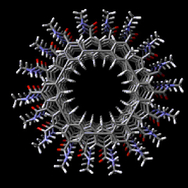A June 25, 2013 news item on Azonano describes a collaborative agreement between the University of Chicago and Ben-Gurion University of the Negev (Israel) to work together and fund nanotechnology-enabled solutions for more water in the Middle East and elsewhere,
The University of Chicago and Ben-Gurion University of the Negev will begin funding a series of ambitious research collaborations that apply the latest discoveries in nanotechnology to create new materials and processes for making clean, fresh drinking water more plentiful and less expensive by 2020.
The announcement came June 23 following a meeting in Jerusalem among Israeli President Shimon Peres, Chicago Mayor Rahm Emanuel, University of Chicago President Robert J. Zimmer, Ben-Gurion University President Rivka Carmi and leading scientists in the field. The joint projects will explore innovative solutions at the water-energy nexus, developing more efficient ways of using water to produce energy and using energy to treat and deliver clean water.
There are more details in the June 23, 2013 University of Chicago news release, which originated the news item (Note: Links have been removed),
The University of Chicago also brings to the effort two powerful research partners already committed to clean water research: the Argonne National Laboratory in Lemont, Ill., and the Marine Biological Laboratory in Woods Hole, Mass.
“We feel it is critical to bring outstanding scientists together to address water resource challenges that are being felt around the world, and will only become more acute over time,” said Zimmer. “Our purification challenges in the Great Lakes region right now are different from some of the scarcity issues some of our colleagues at Ben-Gurion are addressing, but our combined experience will be a tremendous asset in turning early-stage technologies into innovative solutions that may have applications far beyond local issues.”
“Clean, plentiful water is a strategic issue in the Middle East and the world at large, and a central research focus of our university for more than three decades,” said Carmi. “We believe that this partnership will enhance state-of-the-art science in both universities, while having a profound effect on the sustainable availability of clean water to people around the globe.”
The first wave of research proposals include fabricating new materials tailored to remove contaminants, bacteria, viruses and salt from drinking water at a fraction of the cost of current technologies; biological engineering that will help plants maximize their own drought-resistance mechanisms; and polymers that can change the water retention properties of soil in agriculture.
UChicago, BGU and Argonne have jointly committed more than $1 million in seed money over the next two years to support inaugural projects, with the first projects getting under way this fall.
One proposed project would attempt to devise multi-functional and anti-fouling membranes for water purification. These membranes, engineered at the molecular level, could be switched or tuned to remove a wide range of biological and chemical contaminants and prevent the formation of membrane-fouling bacterial films. Keeping those membranes free of fouling would extend their useful lives and decrease energy usage while reducing the operational cost of purifying water.
Another proposal focuses on developing polymers for soil infusion or seed coatings to promote water retention. Such polymers conjure visions of smart landscapes that can substantially promote agricultural growth while reducing irrigation needs.
Officials from both the U.S. and Israel hailed the collaboration as an example of the potential for collaborative innovation that can improve quality of life and boost economic vitality.
You can read more about the University of Chicago’s March 8, 2013 memorandum of understanding with the Ben-Gurion University of the Negev in this March 19,2013 University of Chicago news article by Steve Koppes.
Sidenote: In early May 2013, internationally renowned physicist Stephen Hawking participated in an ‘academic’ boycott of Israel over its position on Palestine. The May 9, 2013 article, Stephen Hawking: Furore deepens over Israel boycott, by Harriet Sherwood, Matthew Kalman, and Sam Jones for the Guardian newspaper reveals some of the content of Hawking’s letter to the organizers and his reasons for participating in the boycott,
Hawking, a world-renowned scientist and bestselling author who has had motor neurone disease for 50 years, cancelled his appearance at the high-profile Presidential Conference, which is personally sponsored by Israel’s president, Shimon Peres, after a barrage of appeals from Palestinian academics.
…
The full text of the letter [from Hawking], dated 3 May, said: “I accepted the invitation to the Presidential Conference with the intention that this would not only allow me to express my opinion on the prospects for a peace settlement but also because it would allow me to lecture on the West Bank. However, I have received a number of emails from Palestinian academics. They are unanimous that I should respect the boycott. In view of this, I must withdraw from the conference. Had I attended, I would have stated my opinion that the policy of the present Israeli government is likely to lead to disaster.”
…
But Palestinians welcomed Hawking’s decision. “Palestinians deeply appreciate Stephen Hawking’s support for an academic boycott of Israel,” said Omar Barghouti, a founding member of the Boycott, Divestment and Sanctions movement. “We think this will rekindle the kind of interest among international academics in academic boycotts that was present in the struggle against apartheid in South Africa.”
Steve Caplan in a May 13, 2013 piece (Occam’s Corner hosted by the Guardian) explained why he profoundly disagreed with Hawking’s position (Note: Links have been removed),
My respect for Hawking as a scientist and person of enormous courage has made my dismay at his recent decision all the greater. In these very virtual pages I have previously opined on the folly of imposing an academic boycott on Israel. The UK, which sports many of the supporters of this policy – dubiously known as the Boycott Divestment and Sanctions (BDS) – also appears to be particularly fertile ground for anti-Semitism. To what degree British anti-Semitism, the anti-Israel BDS lobby and legitimate criticism of Israel’s policies are related is an inordinately complex question, but it is clear that anti-Semitism plays a role among some BDS supporters.
The decision by Hawking to join the boycotters of Israel and Israeli academics is particularly ironic in light of the fact that the conference is being hosted in honor of the 90th birthday of Israel’s president, Shimon Peres. More than any other Israeli leader, Peres has been committed to negotiations and comprehensive peace with the Palestinians, and he was awarded the Nobel Peace Prize for his efforts. At 90, despite his figurehead position, Peres remains steadfastly optimistic in his relentless goal of a fair two-state solution for Israel and the Palestinians.
Caplan’s summary of how the ‘Palestine problem’ was created and how we got to the current state of affairs is one of most the clear-headed I’ve seen,
Pinning the blame on one side with a propaganda machine and a sleeve full of slogans is easy to do, but there is nothing simple or straightforward about the Israeli-Palestinian conflict. From the very birth of the State of Israel in 1948, the mode by which the Palestinian refugee problem was created has been debated intensely by historians. There is little question that a combination of intimidation by Israelis and acquiescence of the refugees to calls by Palestinian and Arab leaders to flee (and return with the victorious Arab armies) were the major causes of Palestinian uprooting.
To what degree was each side responsible? The Palestinians and Arab countries initiated the war in 1948, vetoing by force the United Nations Partition Plan to divide the country between Israelis and Palestinians – in an attempt to prevent any Jewish state from arising. And at the time, Israelis doubtlessly showed little concern at the growing numbers of Palestinians who fled or were forced from their homes. And later, after the Six-Day War in 1967, the Israelis displayed poor judgment (that unfortunately continues to this day) in allowing her citizens to build settlements in these conquered territories.
Both sides have suffered from poor leadership over the years.
Caplan also discusses the relationship between Israel’s government and its academics as he explains why he is opposed academic boycotts,
… in any case, Israeli academics and scientists are neither government mouthpieces nor puppets. There have frequently been serious disagreements between the government and the universities in Israel, highlighting the independence of Israel’s academic institutions. One such example is the Israeli government’s decision last year to upgrade the status of a college built in Ariel – a town inside the West Bank – to that of a university. This was vehemently opposed by Israel’s institutions of higher learning (and by perhaps 50% of the general population).
A second example is the unsuccessful attempt by the Israeli government to shut down Ben-Gurion University’s Department of Politics and Government – which was attacked for its leftist views. The rallying opposition and petition by Israeli academics across the country who warned of the danger to academic freedom helped prevent the department’s closure.
You’ll note the reference to Ben-Gurion University in that last paragraph excerpted from Caplan’s piece, which brings this posting back to where it started, collaboration between two universities to come up with solutions that address problems with access to water. In the end, I am inclined to agree with Caplan that we need to open up and maintain the lines of communication.
ETA June 27, 2013: There is no hint in the University of Chicago news releases that these water projects will benefit any parties other than Israel and the US but it is tempting to hope that this work might also have an impact in Palestine given its current water crisis there as described in a June 26, 2013 news item in the World Bulletin (Note: Links have been removed),
A tiny wedge of land jammed between Israel, Egypt and the Mediterranean sea, the Gaza Strip is heading inexorably into a water crisis that the United Nations says could make the Palestinian enclave unliveable in just a few years.
With 90-95 percent of the territory’s only aquifer contaminated by sewage, chemicals and seawater, neighbourhood desalination facilities and their public taps are a lifesaver for some of Gaza’s 1.6 million residents.
But these small-scale projects provide water for only about 20 percent of the population, forcing many more residents in the impoverished Gaza Strip to buy bottled water at a premium.
“There is a crisis. There is a serious deficit in the water resources in Gaza and there is a serious deterioration in the water quality,” said Rebhi El Sheikh, deputy chairman of the Palestinian Water Authority (PWA).
A NASA study of satellite data released this year showed that between 2003 and 2009 the region lost 144 cubic km of stored freshwater – equivalent to the amount of water held in the Dead Sea – making an already bad situation much worse.
But the situation in Gaza is particularly acute, with the United Nations warning that its sole aquifer might be unusable by 2016, with the damage potentially irreversible by 2020.
![Cetyltrimethylammonium-ion-coated gold nanoparticles before (top) and after (bottom) 500 seconds of electron-beam exposure inside a TEM liquid cell at 200 kV. Scale bar: 100 nm. [downloaded from http://nano.anl.gov/news/highlights/2013_gold_nanoparticles.html]](http://www.frogheart.ca/wp-content/uploads/2013/03/Argonne_Gold_NP.png)
![Among the Picasso paintings in the Art Institute of Chicago collection, The Red Armchair is the most emblematic of his Ripolin usage and is the painting that was examined with APS X-rays at Argonne National Laboratory. To view a larger version of the image, click on it. Courtesy Art Institute of Chicago, Gift of Mr. and Mrs. Daniel Saidenberg (AIC 1957.72) © Estate of Pablo Picasso / Artists Rights Society (ARS), New York [downloaded from http://www.anl.gov/articles/high-energy-x-rays-shine-light-mystery-picasso-s-paints]](http://www.frogheart.ca/wp-content/uploads/2013/02/PicassoRedArmchair.jpg)


